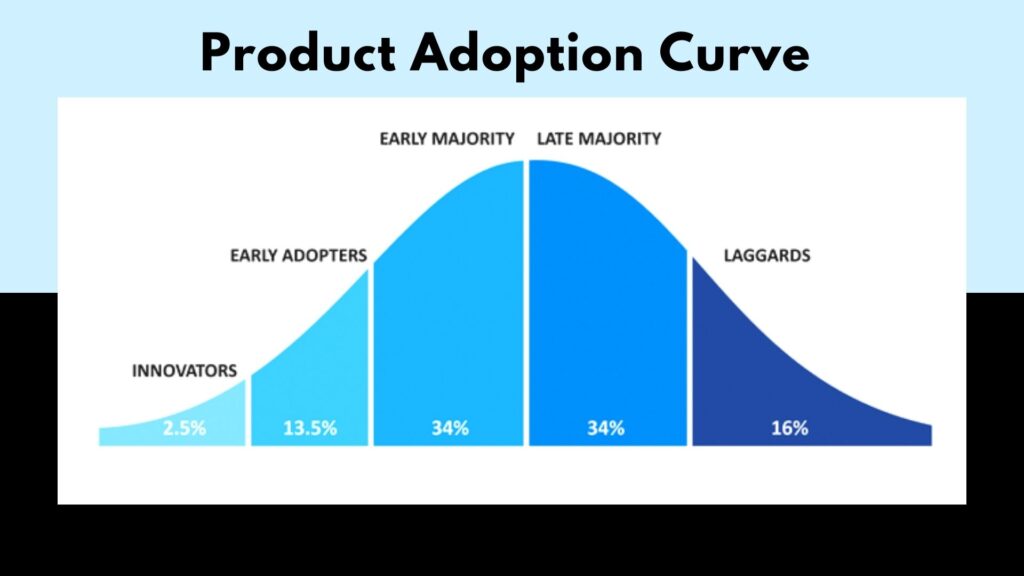What is the diffusion of innovation theory?
The diffusion of innovation theory was first introduced by Everett Rogers in 1962. It emphasizes that the adoption of an innovation is not uniform. Rather, innovations spread through society in the same way as any other product, following a series of “waves” or phases. An idea needs to be introduced to these different groups before it can become widely accepted because it has been found that people will not change their opinion on something until they see other people around them also changing their opinion. This theory states that innovations, or new ideas, will spread through a society based on three main factors:
- Diffusion of Innovations is the change in sales volume over time.
- The rate of adoption is the percentage of people who adopt an innovation in a given period.
- Innovation intensity is the number of adopters per individual innovator.
Five Adopter Groups
The five types of adopter categories according to the diffusion of innovation theory are innovators, early adopters, early majority, late majority, and laggards. Factors such as compatibility, observability, trialability, innovativeness, and persuasion act as a basis of change agents for the potential adopters.

Innovators
The innovators according to the diffusion of innovation theory are the people who introduce new ideas and products to society. According to this theory, these people will be looked up to by other members of society for their innovations. Examples of innovators are Leonardo da Vinci, Steve Jobs, Bill Gates, Elon Musk, and Mark Zuckerberg.
Innovators are people who have the vision and skills to create innovations that improve on existing ones. Innovators tend to believe that they will reap greater rewards for this risk because their early adoption will allow them to gain a competitive advantage over other companies.
Early Adopters
The early adopters are the first to use a new product or service and they usually show enthusiasm for it. They also tend to be more passionate about the product and act as the opinion leaders for the category. According to the diffusion of innovation theory, early adopters are usually people who have an “innovator” mindset that is characterized by being highly creative, having an open mind, being adventurous, being motivated by change and novelty, possessing strong social skills, being tolerant of ambiguity and complexity.
The early adopters also often have low levels of risk tolerance and an innovative mindset, which means they’re willing to take risks on what’s unfamiliar and not yet accepted by society. Finally, early adopters often see a product as a status symbol, which is why they may spend a lot of money on it.
Early Majority
The early majority are the people who enter the market when it is already established. They are considered to be in the lead because they have access to all of the benefits that come with being an early adopter, but they also take on more risk than late adopters. The early majority is the largest demographic of a market and consists of those who have adopted an innovation first.
They are generally considered to be people who makeup around half of the population in a market and include those who are relatively slow adopters. It can be said that by definition, most people will become an early majority, but it depends on how quickly they adopt the new technology.
Late Majority
The late majority is comprised of those who make up about two-thirds of the population. These consumers typically come after the early majority and adopt an innovation later on. The late majority is the group of people who do not adopt a new idea or innovation until it has become widely accepted. Communication channels provide a relative advantage for the average person (early/late majority) to adopt the product with less risk.
Laggards
The last third of a market consists of laggards or reluctant adopters, which includes only 10% or less of consumers. Laggards are people who resist change or adopt innovations slowly. They tend to have a small amount of knowledge about something and have been doing things in a certain way for so long that they cannot imagine anything else being done any differently.
Innovations can also cause laggards because they do not want to change their current way of doing things in fear that they may lose what makes them unique or special. It can be applied to people, institutions, organizations, and markets.
What are the four elements of diffusion of innovation?
1. Introduction – When the idea is first introduced, there are no barriers to adoption and consumers have not yet formed their opinion about the product or service.
2. Diffusion – This phase is characterized by consumers trying out the product or service without pressure from other members of society or any external factors such as government intervention or social norms.
3. Diffusion with benefits – In this phase, some aspects of the innovation have been adopted by a significant portion of society and it becomes easier for others to adopt because they see that others are already using it and it offers them benefits that they were seeking before they began adopting it themselves.
4. Diffusion with costs – At this point, some aspects of the innovation have been adopted by a significant portion of society but there are still many barriers to adoption which make it difficult for those who haven’t adopted yet because they don’t know if they will be able to reap its benefits without incurring its costs first-hand.
How do you use the diffusion of innovation theory?
Marketers can use this theory to help them understand how to market their products or services in order to make sure they reach the right audience and don’t waste money by trying to market towards people who would not buy it. One of the main reasons for the unpredictability of the diffusion process is that it depends on many factors like social influence and psychology which are unpredictable. The pattern of diffusion describes the process by which an innovation gains acceptance into society. This can range from small groups where individuals choose to adopt innovations themselves to large clusters where governmental organizations encourage certain policies through their support.
How does product diffuse through social interaction?
The social system theory explains how innovations achieve widespread adoption through social interaction. While diffusion is about communications or the spread of information, the social system theory takes into account influences on behavior. These include characteristics of perpetrators, who are thought to provide creative ideas and solutions; intermediaries (companies that help diffuse products), people involved in the creation and distribution processes of goods or services, as well as consumers themselves through mass media.
The sociologist Robert k. Merton (1938) noted in his book “Logic of Collective Action” that the study of diffusion was very difficult because it involved a large number of social science disciplines and concerned phenomena not well connected with traditional economic theory. By doing so, he began to try to systematize a new approach in sociology called System Theory which has been described as an interdisciplinary sociological paradigm.
